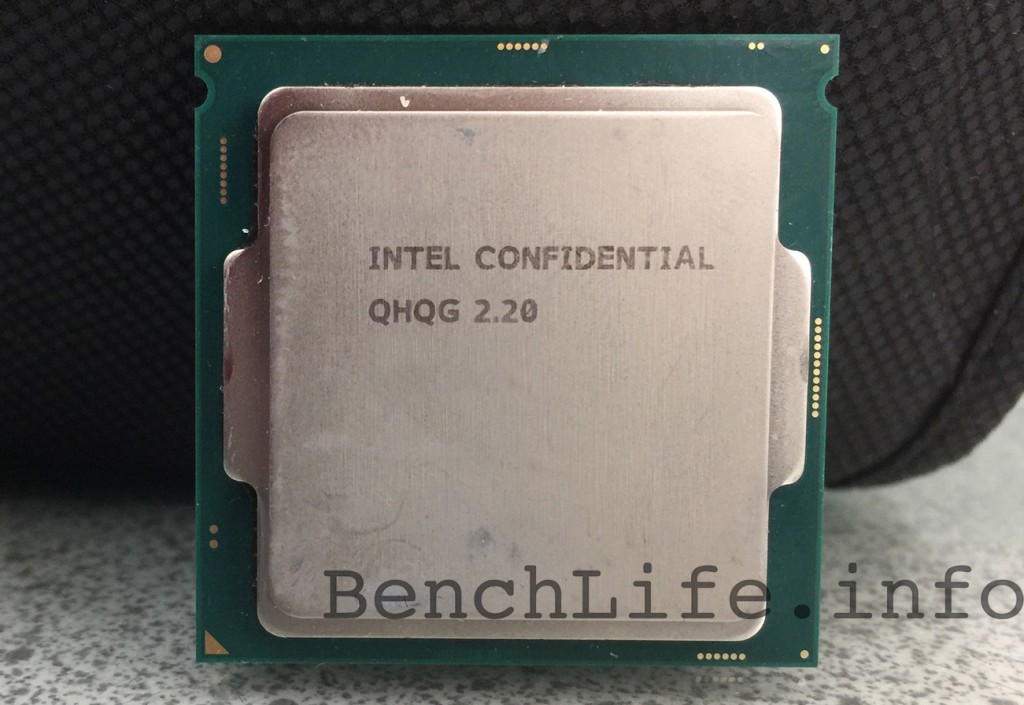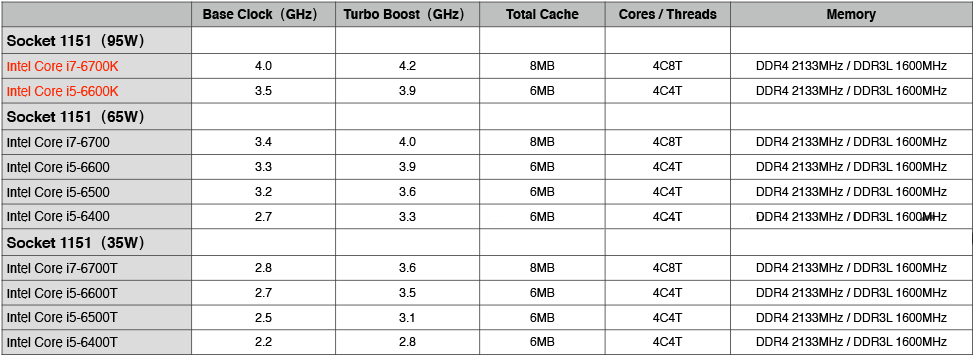A web-site has published what it claims to be specifications of Intel Corp.’s next-generation desktop microprocessors code-named “Skylake-S”. If the information is correct, then the initial “Skylake-S” family will hardly be truly broad and will not impress with high clock-rates.
The upcoming Core i5 and Core i7 “Skylake-S” product lineup will consist of 10 microprocessor models, according to data published by China-based BenchLife web-site, which allegedly obtained an Intel document with specifications of the central processing units. Surprisingly, the initial range of “Skylake-S” microprocessors for desktops will not include any Core i3, Pentium or Celeron offerings, which means that Intel will only target premium market segments with its new chips this year.
There will be three types of Intel “Skylake-S” processors for desktops: with 95W, 65W and 35W thermal design power (TDP) aimed at different classes of PCs. The highest-performing tier of “Skylake-S” with 95W TDP will include only two models with unlocked multiplier: Core i7-6700K and Core i5-6600K. The mainstream “Skylake-S” range with 65W TDP will include four SKUs: Core i7-6700, Core i5-6600, Core i5-6500 and Core i5-6400. The low-power “Skylake-S” family for desktops with 35W TDP will also include four models: Core i7-6700T, Core i5-6600T, Core i5-6500T and Core i5-6400T. Eventually the line of “Skylake-S” products will add more processors, including more affordable Core i3, Pentium and Celeron offerings.
All Intel Core i5 and Core i7 “Skylake-S” processors feature four x86 cores with or without Hyper-Threading technology, a new integrated graphics processor with improved multimedia capabilities, a dual-channel DDR4/DDR3L memory controller and 6MB or 8MB of last level cache (LLC). The chips will feature LGA1151 form-factor and will be compatible with mainboards based on the Intel 100-series chipsets, including Z170, Z150, Q170, Q150, B150 and H110.
It is noteworthy that despite of the fact that the new “Skylake-S” microprocessors are made using 14nm process technology, their clock-rates are rather low. Sometimes they match frequencies of comparable “Haswell” products available today, sometimes they are a tad lower.
The code-named “Skylake-S” central processing units for desktops are projected to hit the market in October.
Intel did not comment on the news-story.
Discuss on our Facebook page, HERE.
KitGuru Says: We do know that microprocessors based on “Skylake” micro-architecture have higher IPC [instructions per clock] performance than chips powered by “Haswell” technology. Therefore, there are no doubts that new CPUs will be faster than the previous-generation products. But will performance gap be wide enough to stimulate users to upgrade?
 KitGuru KitGuru.net – Tech News | Hardware News | Hardware Reviews | IOS | Mobile | Gaming | Graphics Cards
KitGuru KitGuru.net – Tech News | Hardware News | Hardware Reviews | IOS | Mobile | Gaming | Graphics Cards





It`s the usual 10 % better .
< col Hiiiiiii Friends….'my friend's mom makes $88 every hour on the internet . She has been unemployed for eight months but last month her payment was $13904 just working on the internet for a few hours.
try this site HERE’S MORE DETAIL
????????ft
I’m expecting more given the eDRAM.
95W for the chip that matches the 4790K? Seems like Skylake is more of a power hungry beast than even Haswell. Is it so had to get Ivy Bridge’s power consumption again?
I also like how it’s DDR3L or DDR4… with DDR4 being super expensive, and DDR3L being basically nonexistent on the market excepting laptops. 1.35v means less OC potential and likely more relaxed cl timings. Looks like a push for DDR4 is on the way.
i just need to know should i buy haswell G series n get it over with it or hope that broadwell will have i3 or g series too, so far they are only planning for i5 ni7 for desktop.
Hopefully Double Data Rate 4 Random Access Memory will be a bit cheaper by then too. 🙂
Did you forget there’s a 72-EU iGPU (576 SPs vs. 512 in AMD A10 APUs) running at 1+GHz and 64MB of eDRAM L4 cache?
Well that indeed might explain more TDP I suppose… but even so, look at the growing trend:
Ivy Bridge: 77W
Haswell: 88W
Skylake: 95W
The benefits to actual compute power are not there; not great enough for that extra TDP and heat. Even if we can indeed push it because, you know, desktops have huge PSUs etc, I still think the power requirement increases for low IPC bonuses are just too little. Maybe there’s more to it that I don’t know, but an iGPU most people won’t use is blah.
And even then, Haswell is MUCH hotter/power hungry than ivy bridge. I hope skylake isn’t following that trend.
The benefits are there if your application is capable of using SSE 4.2 and AVX 256. Unfortunately in the name of legacy support most game studios play to the lowest common denominator for the target OS. Given that’s windows 7, you’re looking at vanilla x86_64. Not to mention Microsoft’s Visual Compiler is one of the worst of the big names when it comes to optimization. GCC walks all over it, let alone Clang and ICC. Haswell also added a 4th dedicated ALU per core. Used with properly enabled code, the performance differences between the IVB and HW chips are actually very, very high.
Correct me if I’m wrong, but isn’t AVX 256 removed from Skylake? I’m pretty sure I read something about AVX 256 support being removed from a certain chip; I thought that was Skylake.
And you’re right about that fourth ALU, but almost nothing ever uses it, so it’s kind of moot. Besides, why not add it for the enthusiast line, and remove it from the mainstream line of chips? Isn’t that the original point of the enthusiast chips?
But I will agree with you that we eventually need to move on. For certain. There’s so much more optimization to be done and a lot of things are not making use of it. And it doesn’t help that some people won’t upgrade.
AVX 512 is removed from Skylake S, but not E/EP/EX.
< col Hiiiiiii Friends….'my friend's mom makes $88 every hour on the internet . She has been unemployed for eight months but last month her payment was $13904 just working on the internet for a few hours.
try this site HERE’S MORE DETAIL
????????nx
you forgot Broadwell, between Haswell and Skylake with 65W TDP.
Broadwell is basically a failure. Its only prominence right now is in the ULV notebook market, and the desktop chips aren’t unlocked.
ummm the desktop chips are unlocked the “C” means unlocked with Iris Pro graphics. they are definitely not a failure. Low TDP, likely OCs well with water-cooling. Obviously not an upgrade for current 4790k, 4770k owners but for those looking to build a PC very soon its a viable option. Skylake is just around the corner but will be perhaps 10% better than Broadwell at stock speeds. I expect Broadwell to OC better.
Broadwell isn’t out yet in the way you’re saying, and the release roadmaps showed no unlocked CPUs… as for what’s currently released:
http://ark.intel.com/products/codename/38530/Broadwell#@All
Itll be out within a month. They are unlocked CPUs but with low 65w TDP as they are meant for small form factor builds. Should be able to push them past 4.3ghz with good cooling but who knows. The IPC gain is small with Broadwell over Haswell though, so I dont see these chips outperforming an OCd 4790k.
I’ll be waiting to see these 65W unlocked chips, because believe me, Broadwell DOES draw more power than haswell. As haswell drew a LOT more than Ivy Bridge. Skylake seems to be going even further, but no way to tell until we get the chips.
Umm.. failure? It’s a good chip. Intel had Skylake ready so only rolled out Broadwell across mobile at first, there will be a few chips out for desktop too.. but it’s no failure.. do you even read anything about processors? Or just wildly claim poor opinion for shits n giggles?
Whut.
http://www.anandtech.com/show/7003/the-haswell-review-intel-core-i74770k-i54560k-tested/2
Yeah I was indeed wrong about the chips being unlocked or not.
However, broadwell is no real improvement. It’s hotter and pulls more power under load than Haswell, and Haswell already did more than Ivy Bridge and ran quite a bit hotter. Desktop users with super cooling situations probably don’t care, but if people are going to rag on AMD’s CPUs and say how freaking hot they are (which they are) then I’m going to do the same for Intel’s lines.
Please note: my information/research comes from the notebook market, where temperatures and power draw make QUITE a bit of difference. It’s more negligible in desktops because of an overabundance of power and cooling systems in the higher end machines, but higher end notebooks and lower end ones scrounging for battery life and quiet fans, you see differences more readily. From what we’ve seen, haswell/broadwell do best at low frequencies and loads, and worse in efficiency at high frequencies/loads, ESPECIALLY above stock.
Oh no. In fact I do quite a bit of research and reading about them, however when I speak of things like “efficiency” or “heat” or “power draw” etc, I’m speaking from the view of the notebook market users, who have to manage heat/power/battery life/etc much more than desktop users with their overabundant cooling and power supplies. My words have quite a bit of weight to them. Just because you can shove a high end cooling system and a 800W PSU on any CPU out there, doesn’t mean it’s a power guzzling chip or that it gets super hot. If people rag on AMD chips for being hot and power hungry, I don’t see why I shouldn’t rag on intel’s for doing the same. Especially coming down from Ivy Bridge.
Also, Broadwell was quite delayed. It was supposed to be out in 2014 and got pushed back so much with Intel trying to make good gains out of the 16nm process and the Broadwell Architecture that Skylake creeped up. Intel’s done working on them. Hell, Intel’s probably done working on Cannonlake too. They’re working on what’s after Cannonlake. We just don’t have consumer releases for them. If you look back, they’ve debuted working samples of various architectures months in advance of their release dates.